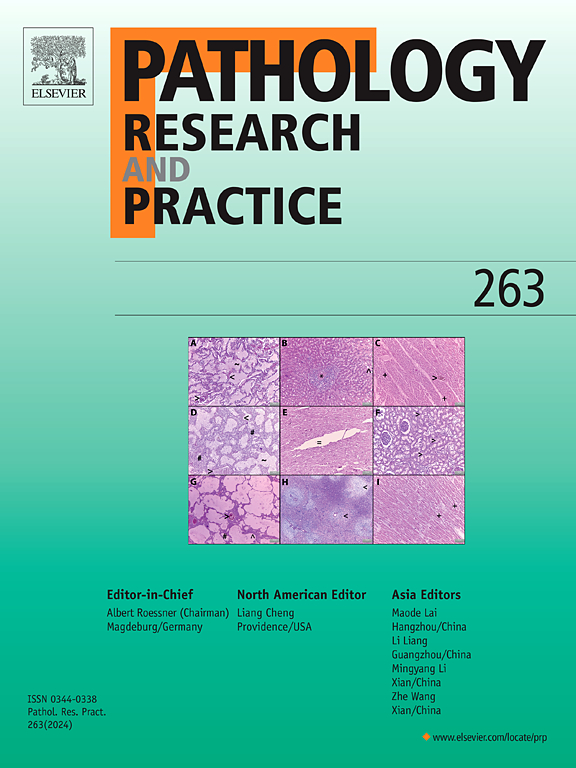CircWDR37 promotes hepatocellular carcinoma tumorigenesis by mediating the miR-646/TRAF4 regulatory pathway
IF 2.9
4区 医学
Q2 PATHOLOGY
引用次数: 0
Abstract
Background
CircRNA has emerged as a significant player in human malignancies, including hepatocellular carcinoma (HCC). Hsa_circ_0004277 (circWDR37) is abnormally up-regulated in HCC. But, its function and underlying mechanism in HCC progression are largely unknown.
Methods
qRT-PCR and western blot assays were used to measure the expression of circWDR37, miR-646, and TRAF4. Cell malignant phenotypes were assessed via CCK-8, EdU, colony formation, flow cytometry, transwell, and tube formation experiments. The intermolecular interaction between miR-646 and circWDR37 or TRAF4 was confirmed by dual-luciferase reporter and RNA immunoprecipitation (RIP) assay. The in vivo effect of circWDR37 on xenograft tumor growth was also investigated in mice.
Results
Increased CircWDR37 and TRAF4 and decreased miR-646 were found in HCC tissues and cells. Scilencing circWDR37 impeded cell proliferation, migration, invasion, and tube formation, while accelerated apoptosis. CircWDR37 directly bind to miR-646 to suppress miR-646 expression and up-regulate TRAF4 expression. MiR-646 inhibitor partially abated the cell phenotype changes caused by circWDR37 knockdown. Moreover, miR-646 exerted an inhibitory effect on cell malignant phenotypes, which were attenuated due to the increase of TRAF4. Additionally, circWDR37 knockdown blocked HCC tumor growth in vivo.
Conclusion
CircWDR37 exerted an oncogenic effect in HCC by sponging miR-646 to up-regulate TRAF4 expression. Our finding elucidates a novel ‘circWDR37-miR-646-TRAF4’ regulatory axis in HCC and provides a promising target for HCC treatment.
CircWDR37 通过介导 miR-646/TRAF4 调控途径促进肝细胞癌肿瘤发生
背景:CircRNA 在包括肝细胞癌(HCC)在内的人类恶性肿瘤中发挥着重要作用。Hsa_circ_0004277 (circWDR37) 在 HCC 中异常上调。方法:采用 qRT-PCR 和 Western 印迹检测 circWDR37、miR-646 和 TRAF4 的表达。通过CCK-8、EdU、集落形成、流式细胞术、transwell和试管形成实验评估细胞恶性表型。通过双荧光素酶报告和 RNA 免疫沉淀(RIP)实验证实了 miR-646 与 circWDR37 或 TRAF4 分子间的相互作用。此外,还研究了 circWDR37 对小鼠体内异种移植肿瘤生长的影响:结果:在 HCC 组织和细胞中发现 CircWDR37 和 TRAF4 增加,miR-646 减少。抑制 CircWDR37 会阻碍细胞增殖、迁移、侵袭和管形成,同时加速细胞凋亡。CircWDR37 直接与 miR-646 结合,抑制 miR-646 的表达,上调 TRAF4 的表达。miR-646抑制剂部分缓解了circWDR37敲除引起的细胞表型变化。此外,miR-646 对细胞恶性表型也有抑制作用,而细胞恶性表型因 TRAF4 的增加而减弱。此外,circWDR37敲除可阻止HCC肿瘤在体内生长:结论:CircWDR37通过上调miR-646来上调TRAF4的表达,从而在HCC中发挥致癌作用。我们的发现阐明了HCC中一个新的 "circWDR37-miR-646-TRAF4 "调控轴,并为HCC治疗提供了一个有前景的靶点。
本文章由计算机程序翻译,如有差异,请以英文原文为准。
求助全文
约1分钟内获得全文
求助全文
来源期刊
CiteScore
5.00
自引率
3.60%
发文量
405
审稿时长
24 days
期刊介绍:
Pathology, Research and Practice provides accessible coverage of the most recent developments across the entire field of pathology: Reviews focus on recent progress in pathology, while Comments look at interesting current problems and at hypotheses for future developments in pathology. Original Papers present novel findings on all aspects of general, anatomic and molecular pathology. Rapid Communications inform readers on preliminary findings that may be relevant for further studies and need to be communicated quickly. Teaching Cases look at new aspects or special diagnostic problems of diseases and at case reports relevant for the pathologist''s practice.

 求助内容:
求助内容: 应助结果提醒方式:
应助结果提醒方式:


